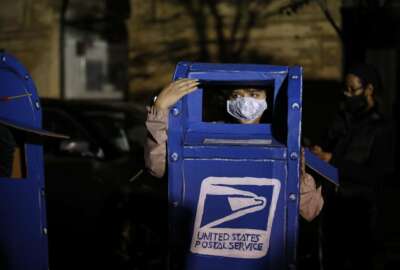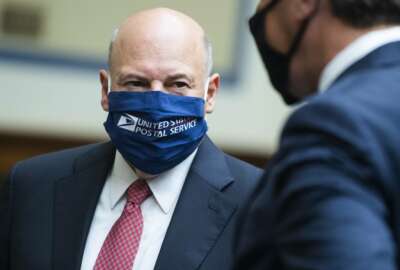

Hubbard Radio Washington DC, LLC. All rights reserved. This website is not intended for users located within the European Economic Area.
Expenses rose, but so did financial liquidity. That sort of summarizes what happened to the U.S. Postal Service throughout the pandemic. The cost and pricing au...
Tom Temin: Expenses rose, but so did financial liquidity. That sort of summarizes what happened to the U.S. Postal Service throughout the pandemic. The cost and pricing audit director for the USPS Office of Inspector General, Sherry Fullwood, joined the Federal Drive with Tom Temin with more on what a detailed look at the USPS found.
Ms. Fullwood, good to have you on.
Sherry Fullwood: Good morning.
Tom Temin: So everyone kind of had the sense that there would be a financial impact, probably many of them, on the Postal Service from the pandemic. And that’s what you were trying to find out in general?
Sherry Fullwood: Generally speaking, yes.
Tom Temin: All right, and tell us basically what you found out here.
Sherry Fullwood: Well, this report focused on three primary areas, and that was the increase in expenses. How the Postal Service attributed the expenses to products in lieu of the restrictions for social distancing, and not being able to get into the plants to track the way the mail is being moved around, and the impact on liquidity. Our liquidity assessment was in line with what the Postal Service reported. We did find that the way they developed supplemental processes to identify the mail movement and therefore attribute the costs to the products. The biggest finding was with regards to the expenses in terms of tracking and validation, where we noted that there were some gaps in how the expenses were tracked and reported and validated.
Tom Temin: And let’s talk about those expenses for the moment. What expenses tended to rise the most? Where did they have to pay the bill here for the pandemic?
Sherry Fullwood: It was a little bit of a mixed bag, and what we found changed, not drastically, but somewhat, when they — based on a report — they basically built a more robust workbook that better track and validated the expenses from what we originally reviewed as being the report. But when we started looking at it, the major cost drivers were moving mail from air to surface because a lot of the air wasn’t as available. And then the increase in parcels meant that there’s less space on the vehicle. So there’s an increase in transportation costs due to moving more packages than actual mail. Also, there’s PP and E, which is obviously something that no one had prepared for, because we don’t have gloves in mass volume laying around and masks and things like that. That was another major cost driver, and then the change in employee availability, where you have less people in the plants, but the work was actually increasing with the increased parcel volume and having to now find staff because a lot of people were out due to COVID. And so they had to do a lot of new hiring, and training and things like that.
Tom Temin: So pretty much across the board then, everything connected was getting the mail delivered, and yet the liquidity of the Postal Service went up. And that’s been a long term issue for them. What did you find with respect to liquidity? And how did that happen?
Sherry Fullwood: Liquidity primarily rose based on several factors. One, the Postal Service had defaulted on $7.8 billion in retiree payments. They deferred their social security taxes. In an agreement that was set to expire in April of 2020, they borrowed $3.4 billion based on that agreement, not knowing what was going to happen, because that was at the beginning of the pandemic. They also reduced a lot of planned capital expenditures, and the increase in parcel volume helped drive some revenue increases in that area. So it’s a combination of a lot of things they did earlier on, I would say, in the pandemic that allowed their liquidity to be higher than anticipated.
Tom Temin: We’re speaking with Sherry Fullwood. She’s cost and pricing audit director for the Office of Inspector General at the Postal Service. And you mentioned the expenses rose, the liquidity rose, but there were issues with how the Postal Service could assign the cost increases to the specific products that they offer. Is that what you’re trying to explain?
Sherry Fullwood: So with regards to the how they assign the costs of products, typically what happens is, they have people that go into the plants, they go look at the transportation vehicles, there are people that are sampling the mail as it moves. And based on that sample, they can come to determine what percentage of various costs. Like if I were sampling a mail carrier, I can then say, Okay, this mail carrier is doing 10% of this type of mail and 20% of that type of mail. And I’m very much trying to make this an easy example for people to follow. It’s a lot more detailed than that. But they’re sampling the mail to see how that mail is moving, and then they say ‘ok, mail carrier labor costs are x.’ And based on what they were actually carrying, we can determine what percentages of their labor costs are going to be attributed to that product.
Tom Temin: So in other words, in normal times, a mail truck has a load of stuff, there’s packages, there’s first class mail, there’s commercial mail, there’s periodicals and they are able to figure out what percentage each type of product is and then assign the total cost of that mail run, say, the gasoline and the labor and so forth to the various classes of products in proportion to how they’re loaded on the truck?
Sherry Fullwood: Theoretically, yes, and it wouldn’t be the total, because there’s, like I said, there’s some other factors that go into it. But the portion of those costs that are determined to be borne by mail products would then be divvied up between the mail products based on those percentages. The technicians that normally sample the mail weren’t able to always get in to sample the mail due to social distancing and other COVID restrictions, you know, for the safety of them as well. And so what they did was they were able to use one of their other data systems to get the data that they needed, so that they could then make sure they had up enough sample, so to speak, to attribute the cost to the products.
Tom Temin: Got it. So it sounds like that could maybe be a permanent workaround, if it’s accurate?
Sherry Fullwood: They’re evaluating it now to see if that is something that they can put into place on a permanent basis. And that will be utilizing data from a system as opposed to people touching the mail.
Tom Temin: Yeah, because every piece of mail has a barcode, it seems like that might be a clue as to where you could find out that particular data of what type of mail it is, and therefore what the costs attributed to it might be.
Sherry Fullwood: Yes, that is what they’re evaluating now. And then they would have to propose that with the PRC for approval.
Tom Temin: So adding this all up, what are your main recommendations for the Postal Service?
Sherry Fullwood: Our main recommendations, the largest concern that we had and what we recommended was that there wasn’t a documented process — they had a process in place for how to track and validate expenses due to natural disasters or smaller, local unanticipated events. They did not have anything in place for a nationwide exigent event, whether it be a pandemic or other crises. So took some time to kind of develop something that made sense. And what they were doing originally was everyone was just kind of grabbing their costs from the various places and estimating costs, but uniformity wasn’t there. So our recommendation was to develop a uniform process that somebody can kind of follow to say, Okay, if something happens, particularly on a larger scale level, how should we be tracking these costs? How should we validate these costs? So there’s a little bit of a roadmap to follow in the future, so people don’t have to pivot when something unexpected comes up.
Tom Temin: And they went along with the recommendations, they agreed with you?
Sherry Fullwood: They did agree with us and they have developed a stronger workbook, they have shared it with us, we have looked through it. We have not assessed it, or audited it, but just on the face of what we saw it is an improvement from what they gave to us to begin this audit. And when they are completed, they would give that to a further review to close out the recommendations.
Tom Temin: All right, Sherry Fullwood is cost and pricing audit director for the Office of Inspector General at the US Postal Service. Thanks so much for joining me.
Sherry Fullwood: Thank you very much. Have a good day.
Copyright © 2024 Federal News Network. All rights reserved. This website is not intended for users located within the European Economic Area.
Tom Temin is host of the Federal Drive and has been providing insight on federal technology and management issues for more than 30 years.
Follow @tteminWFED



